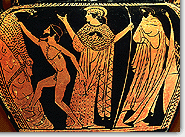



   | |
|
|
The distinction among various poetic genres is usually clearer musically than metrically. Elegy was often accompanied by the flute and was the only genre that required two executants. On the contrary, because the epic was sung with the accompaniment of the guitar and monody with the accompaniment of the lyre or lute, it could be presented by only one executant. Although the word elegy comes from elegos, lament, the elegiac metre was also used for poetry of a totally different context. |  |
Archilochus of Paros is undoubtedly the most important of the lyric poets and his posthumous fame was great. He occupied a special position in the education of the classical period, next to Homer and Hesiod. He lived an eventful and disreputable life, most probably as a mercenary and he was killed in a battle by someone named Calondas of Naxos. His life was connected to chronologically historical events, the kingdom of Gyges
Although he depended a lot on epic, he introduced some speech innovations and used various metres, a fact that reveals the existence of a developing poetic tradition before him. Archilochus often used the first person and led some scholars to think that his poetry was autobiographical. Apparently Archilochus played certain roles, among which were those of the professional soldier and the lover, a usual phenomenon in the folk culture and the oral tradition.
 | Contemporary to Archilochus was Callinus of Ephesus. Only small extracts survive from his work and the most interesting ones are the military songs. The material of the tradition, such as the borrowed comparisons from Homer's work, develop a vividness and an emotional directness in Callinus' poetry. |
Among those who wrote elegies and iambs in thr Archaic period, Solon the Athenian, Semonides of Amorgos and Hipponax of Ephesus are notable. Simonides was known in antiquity for his satirical poems, but quite often he was mistakenly identified with Simonides of Ceos, who preceded him.
|
| |
|
Note: Click on picture for short description. | |